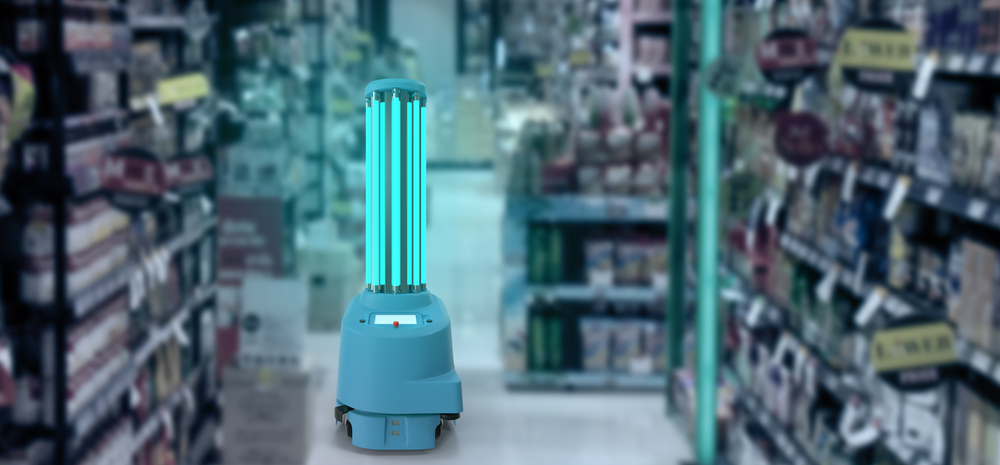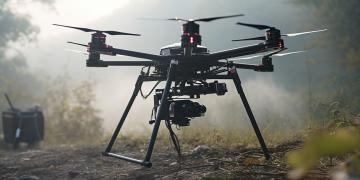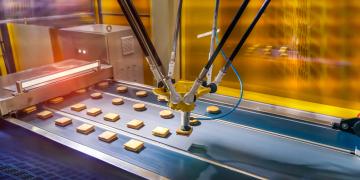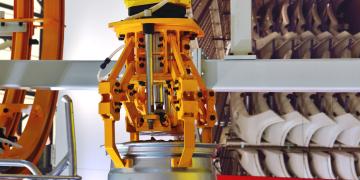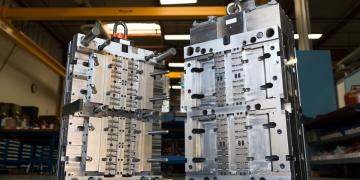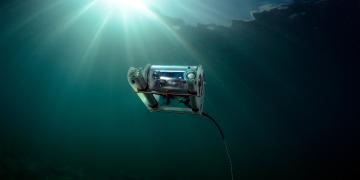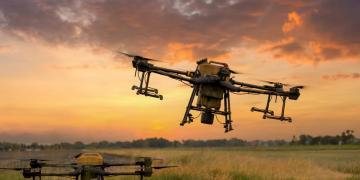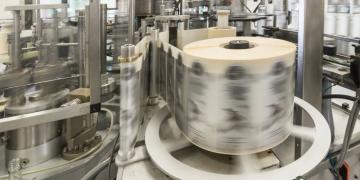Methods of automated disinfection were already beginning to emerge before 2020. However, the demands of the COVID-19 pandemic only accelerated the proliferation of this unique technology. UV robots blend cutting-edge robotic technology and the highest standards for environmental disinfectants to provide an automated sterilization solution for industrial and commercial end users. This article covers the basics of UV robots, their industries, how to source one, and critical considerations to make when integrating one in your facility.
What Are UV Robots?
UV robots are mobile robots deployed in UV-based sterilization applications. This application was relatively niched before COVID-19 but has seen a surge in popularity due to the pandemic. UV robots move autonomously within a pre-defined region to perform their sterilization task. They do this by using a special light that emits UV radiation. Afterward, they typically move on to their next assignment or a charging station. Robots are beneficial for this application since UV radiation can be dangerous to handle directly by people.
Why UV?
UV radiation for sterilization is a proven method to significantly reduce the number of infectious bacteria and viruses in the local environment. Basic cleaning practices are a primary but potentially insufficient strategy for reducing the risk of infectious diseases. The CDC estimates that 687,000 healthcare-associated infections (HAIs) occurred in U.S. acute care hospitals in 2015. Subsequently, 72,000 patients died during their hospitalizations with HAIs that year. The importance of proper sterilization can’t be overstated. It’s important to remember that UV methods are a supplement, not a replacement, for traditional cleaning methods.
Types of UV Robots
There are a few types of UV robots available to you. The use case is the same: automated sterilization via UV radiation. However, the underlying technology and deployment can vary. Let’s look at two main categories of mobile robots used for this application.
Automated Guided Vehicles (AGVs)
AGVs are the traditional mobile robot technology. This mobile robot type has been operating in industrial applications for decades. The primary characteristic of AGVs is fixed navigation. These robots follow landmarks such as colored or magnetic tape, wires, or radio signals to get around. They operate well in predictable and stable environments. As a result, AGVs can be more cost-efficient in some applications. However, due to potential infrastructure modifications, the cost ceiling for an AGV integration can be high in other circumstances.
AGVs follow fixed paths to apply UV light to objects and surfaces. They are predictable and follow simple step-by-step commands. More unpredictable workplaces can cause issues for AGVs since they aren’t able to make adjustments dynamically. AGVs will require infrastructure adjustments to operate in your facility. Be prepared to make these changes if you’re considering an AGV.
Autonomous Mobile Robots (AMRs)
AMRs are the modern successor to AGV technology. These robots use a combination of visual feedback, environment mapping, and machine learning to determine the best path forward. It can adjust to obstacles and environmental changes to reach its destination. Sophisticated fleet management software reflects this flexibility. These tools allow multiple AMRs to operate in tandem to find the most efficient solution to balance a complex workload. Flexibility makes costs more predictable since a few AMR configurations can cover the whole range of mobile robot applications.
AMRs freely navigate their workspace to find the best path to their destination. No tape or special peripherals are requirements for these robots to navigate compared to AGVs. The AMR is much better positioned to operate in dynamic environments. This gives it an advantage over AGVs in many circumstances. Modern medical, manufacturing, and retail facilities have to contend with considerable foot traffic and a changing floorspace.
UV Robot Alternatives
Vaporized chemical disinfectants exist as an alternative to UV-based sterilization. This method uses a vaporized disinfectant such as hydrogen peroxide. The chemical compound is dispersed in the air using misting technology. This process tends to take 2-3 times longer to complete. The extended time is due to the time needed for the mist to settle and dry.
Additionally, you’ll need to do more prep work since you must seal doors and vents. Some configurations require a second machine to aerate the room. This process accelerates the decontamination process.
Primary Industries for UV Robots
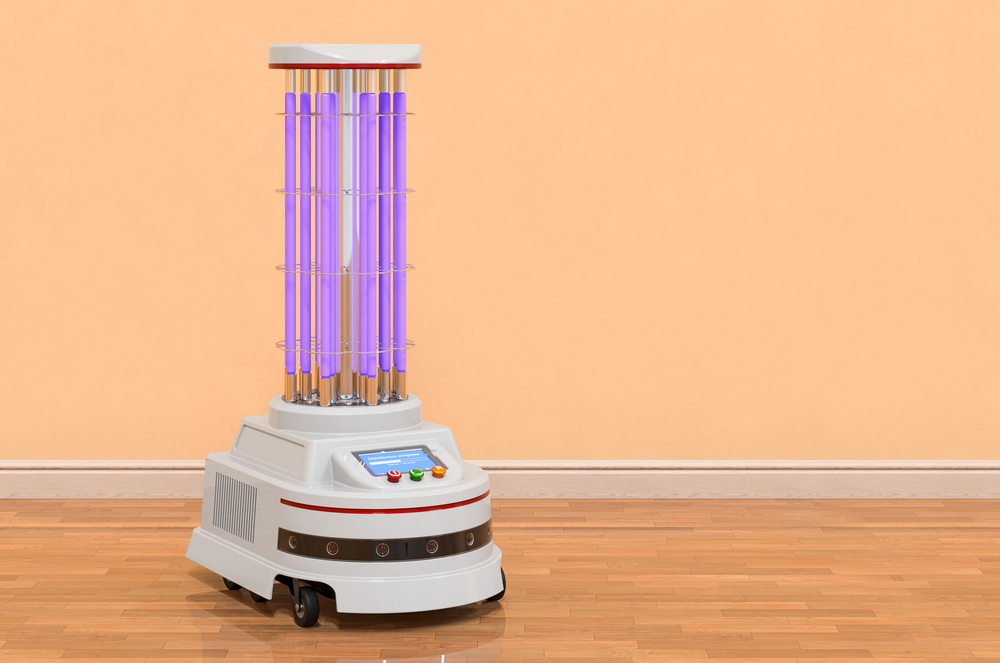
It’s no surprise that healthcare-related fields are the core market for UV robots. The importance of maintaining a sterile environment is crucial for these users. The impact of bacteria and viruses can be critical in healthcare settings. However, due to the lasting effects of the COVID-19 pandemic, the interest in automated sterilization technology has expanded significantly. Now, more than just healthcare facilities have to consider the importance of proper disinfecting.
Hospitals and Healthcare Facilities
Hospitals and healthcare facilities have a critical need for surface sanitization. They also tend to have people in the building that are most sensitive to contaminants. These reasons make hospitals and healthcare facilities a core market for UV disinfection robots.
Medical Device Manufacturers
The relationship between medical device manufacturers and healthcare facilities mean that manufacturers have a high standard for sterilization. It’s crucial for manufacturers to maintain a clean environment during production and packaging. Cleanroom standards apply for most medical device manufacturers. UV robot sterilization supplements these standards by creating sterile surfaces to limit the transmission of microbes.
Food and Beverage Manufacturers
Food and beverage facilities are often under strict requirements for hygiene. The close proximity to the food we consume means these companies must be mindful of how food is handled and how contaminants might come into contact with the product. UV sterilization can be a powerful complement to the many ways manufacturers control contaminants. Sterilization of common surfaces is the primary application of UV robots in these facilities.
Retail and Grocery Chains
Retail environments are the last stop before the product reaches the customer. Surface and packaging sterilization is an important step in protecting customers from microbes that could cause illness. UV robots patrolling aisles to provide a level of disinfectant is becoming a more common sight in modern retail locations.
How to Source a UV Robot
At this stage, it may be clear that your facility could benefit from a higher degree of sterilization. A UV robot might be the correct path forward for you. As these robots are an emerging technology, sourcing them may be more challenging than finding more traditional industrial robots.
UV robots can be sourced from two main groups of providers. The primary source is the robot manufacturer. Alternatively, system integrators can offer UV robot solutions. Both offer hardware, software, and installation services, but working with either group has its pros and cons. Understanding these differences helps you to make a more informed decision. Additionally, finding the right supplier for you increases the likelihood of smooth and successful integration.
The Manufacturer
Manufacturers of robot technologies often offer direct sales channels to consumers. Working with manufacturers has its perks. Manufacturers know their hardware and software better than anyone else. They also tend to have more high-trained engineering resources on staff. In addition, manufacturers excel at quickly integrating packaged solutions for standard applications.
Manufacturers can be hesitant to offer custom solutions. This sensitivity is because they are brand-aware and prefer to work within known parameters. However, custom solutions increase the unknowns during and after integration, which can be risky for OEMs. Additionally, they tend to be less flexible when making their solutions work with other brands. For example, OEMs may be less willing to dedicate resources to make their solution work with a competing manufacturer’s technology. Manufacturers usually consider this a risk since competing technologies introduce unknown parameters.
System Integrators
System integrators are 3rd party suppliers that offer parts and integration services. Integrators often partner with OEMs in an official capacity. This partnership typically includes training and maintaining standards of expertise about the product. Additionally, integrators typically carry multiple brands and product types. This range of options allows system integrators to offer more custom solutions for their customers. This flexibility enables them to take on projects that OEMs can’t or won’t. System integrators are more willing to work with competing technologies and merge them to achieve the desired outcome.
Integrators are highly trained on the equipment they sell. However, they typically aren’t as knowledgeable as the manufacturers. As a result, they’ll have to rely on the OEMs to provide answers and guidance if they run into issues. In addition, system integrators have fewer engineering resources to deploy for highly technical applications. Finally, they can be limited on the level of discounts they can provide since they’re restricted by their own purchase cost from the OEM.
It’s important to note that in many applications, it’s common to leverage OEM and integrator resources. So be sure to communicate with your suppliers to understand your options!
Are you ready to search for suppliers but don’t know where to start? HowToRobot’s online platform makes it easy to explore your options. Our tools allow you to find suitable suppliers and begin receiving quotes for your project risk-free and anonymously. Contact us today to get started.
Key Considerations
UV sanitization tasks are an excellent use of mobile robot technology. However, there are some considerations you should make before making a decision. These considerations include:
- What type of sanitation do you require?
- What type of robot is right for you?
- Do you want to work with an OEM or an integrator?
Having these questions answered will help you speed up your robot search. Many suppliers specialize in UV-based robot sanitation due to its higher performance. However, there may be circumstances that would require you to consider a chemical-based solution. For example, applying a chemical-based compound to materials sensitive to UV radiation might be a better solution.
AMRs and AGVs both have their strengths and shortcomings. The specifics of your application and environment will help you determine which is right for you. A walkthrough of your facility would be beneficial for choosing the best path forward. Your supplier should be able to offer more guidance after a more detailed look at your automation project.
Finally, you should determine if you want to work directly with the OEM or a supplier. Some partnerships might have standards where the consumer always works directly through one party. On the other hand, complex applications might require that you work with both parties. Be sure to get perspectives from both parties and determine with whom it makes more sense for you to work. With these questions answered, you’re well on your way toward a successful automation journey.

